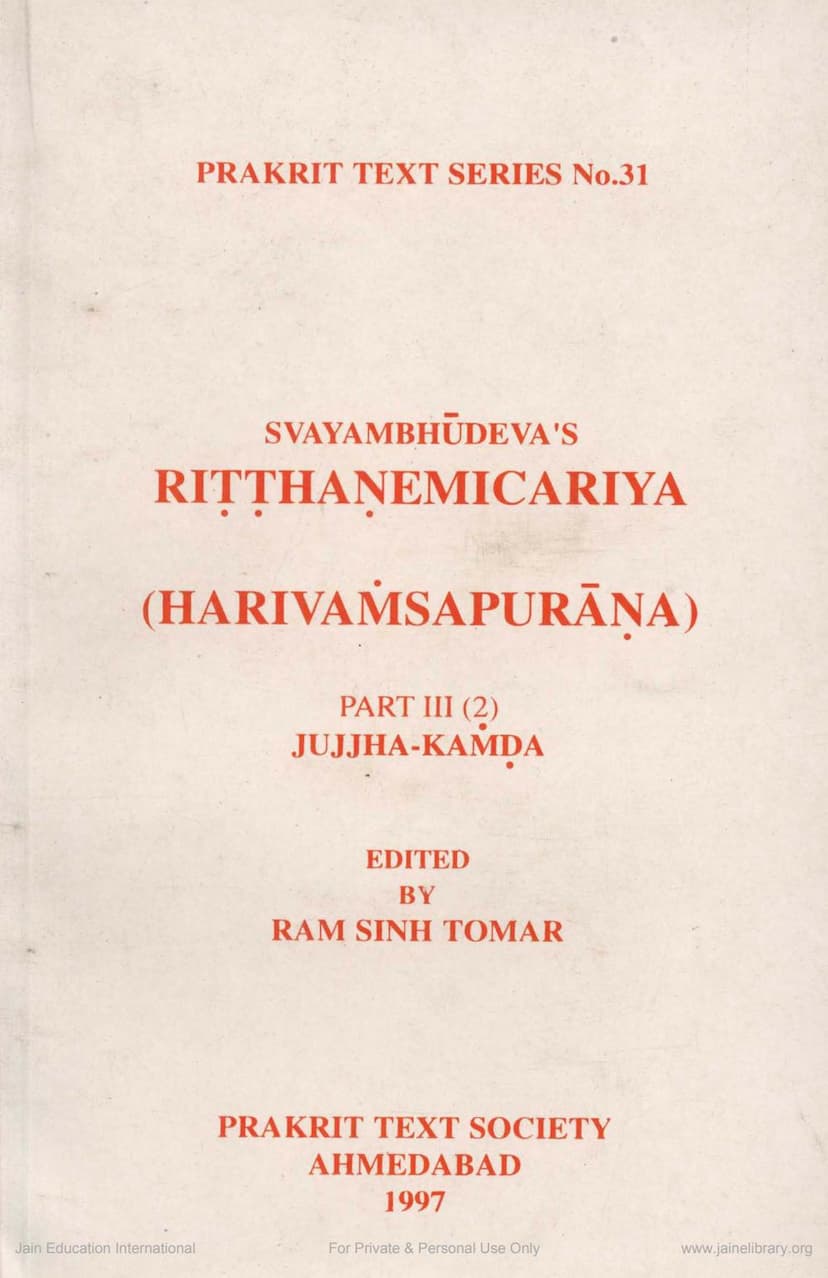Ritthnemichariyam Part 3 2
Added to library: September 2, 2025

Summary
This document is the third part (second section) of Swayambhudeva's Ritthanemicariya, also known as the Harivansapurana. Titled "Jujjha-Kanda" (the Chapter of Battle), it was edited by Ram Sinh Tomar and published by the Prakrit Text Society, Ahmedabad, in 1997.
Key information from the provided pages:
- Title: Ritthanemicariya (Harivansapurana) Part III (2) Jujjha-Kanda
- Author: Swayambhūdeva (with editing by Ram Sinh Tomar, Dalsukh Malvania, H C Bhayani)
- Publisher: Prakrit Text Society, Ahmedabad
- Publication Year: 1997
- Series: Prakrit Text Series No. 31
- Content: This volume covers Sandhis (chapters) 64 to 92 of the Jujjha-Kanda.
- General Editors' Foreword: The foreword by H.C. Bhayani highlights the significance of Swayambhudeva's work as a link in the tradition of Mahabharata narratives. It notes Swayambhu's evident dependence on the Drona, Karna, and Shalya Parvans of the Mahabharata. Bhayani also points out an interesting coincidence: Swayambhu himself recorded that it took him six years, three months, and eleven days to write the 92 sandhis of the Yuddha-Kanda, a duration remarkably similar to the time taken for the printing and publication of this portion of the work (1991-1997).
- Textual Content: The bulk of the document consists of the Prakrit text of the Ritthanemicariya, specifically the battle sequences (Sandhis 64 through what appears to be up to Sandhi 92, based on the table of contents). The text details various battles, encounters between warriors, descriptions of weapons, chariots, elephants, horses, and the ferocity of combat. The language is Prakrit, and the structure includes verses and ghattas (couplets or short verses summarizing a section). The content is deeply rooted in the narrative style and events commonly found in Indian epic literature, particularly the Mahabharata.
Summary of the "Jujjha-Kanda" (Chapter of Battle) as presented:
The Jujjha-Kanda, as indicated by the sandhi titles (Chausatthimo Sandhi - 64th chapter, Panchasattimo Sandhi - 65th, etc.), focuses on the intense and detailed accounts of battles. Based on the provided text, the narrative seems to cover significant combat events, likely within the broader story of Neminatha's life and the conflict associated with the Vrishni and Kaurava clans.
The text vividly describes:
- Warrior duels: Encounters between prominent heroes like Arjuna, Bhima, Karna (Sinini-nandanu), Drona, Duryodhana, and others are depicted with graphic detail.
- Battle formations and strategies: The text likely alludes to various military formations and tactics.
- Weaponry and Armaments: Descriptions of bows, arrows, maces, swords, chariots, and other war equipment are present.
- The ferocity of war: The Prakrit verses paint a picture of a fierce and bloody conflict, with descriptions of fallen warriors, bloodshed, and the chaos of battle.
- Divine intervention and omens: As is common in such epics, there are likely subtle or overt references to divine favor or unfavorable omens influencing the course of the battle.
- Emotional and psychological aspects: The verses capture the anger, pride, determination, and sorrow of the warriors.
Specific Sandhis (Chapters) Covered:
The table of contents (Vishayanukram) lists Sandhis 64 through 92. The provided text begins with Sandhi 64 (Chausatthimo Sandhi) and continues through Sandhi 77 (Sattasattimo Sandhi) and then jumps to Sandhi 81 (Ikkanavaiimo Sandhi), 82 (Bayasiimo Sandhi), 83 (Teyasiimo Sandhi), 84 (Chuhurasiimo Sandhi), and 85 (Panchasiimo Sandhi). The end of the Jujjha-Kanda is marked by the conclusion of Sandhi 92, according to the General Editors' Foreword. This indicates that the provided text is a significant portion of the Yuddha-Kanda.
In essence, this volume is a scholarly presentation of a crucial and action-packed part of the Ritthanemicariya, focusing on the martial exploits and descriptions of warfare within the epic narrative.